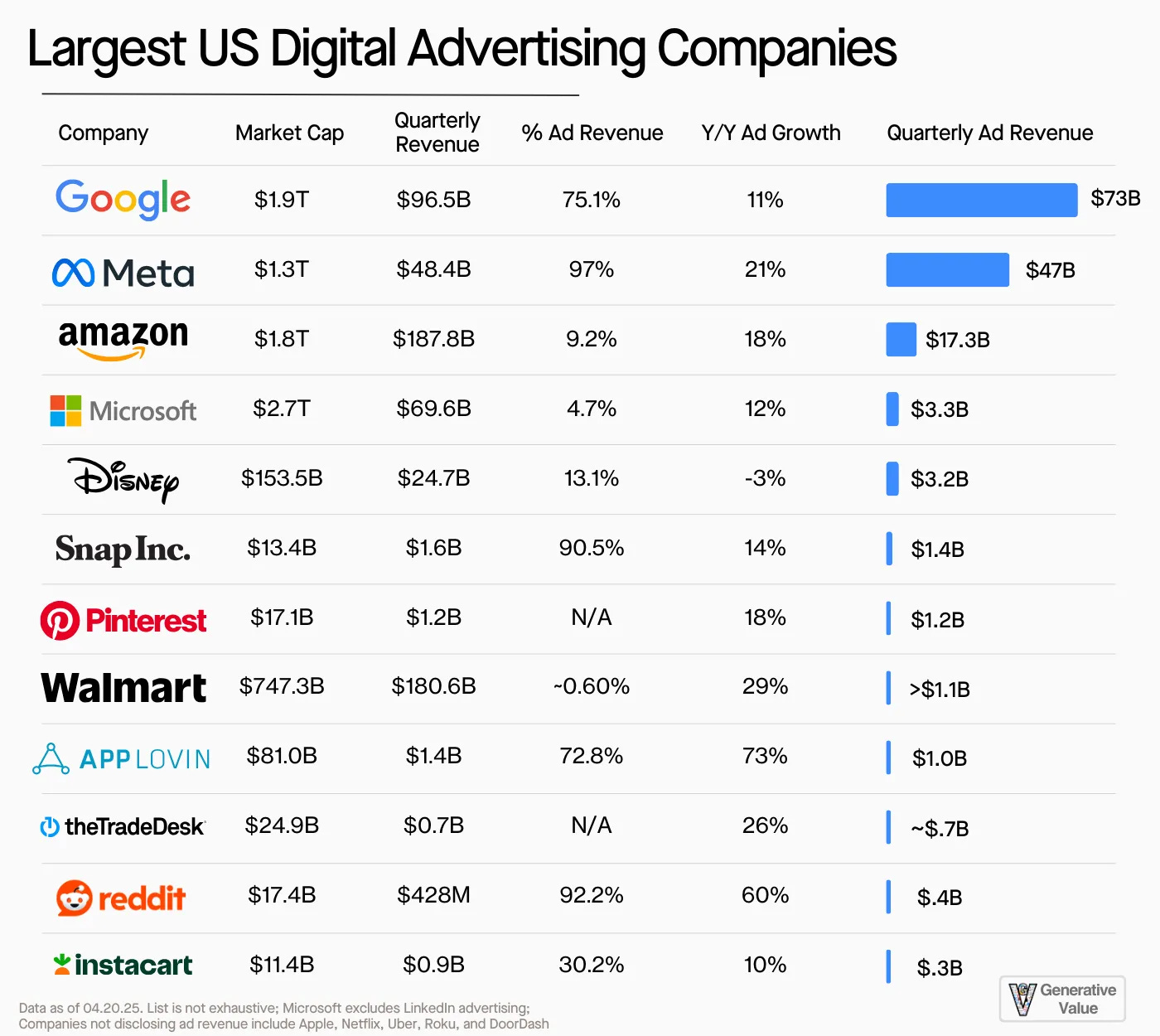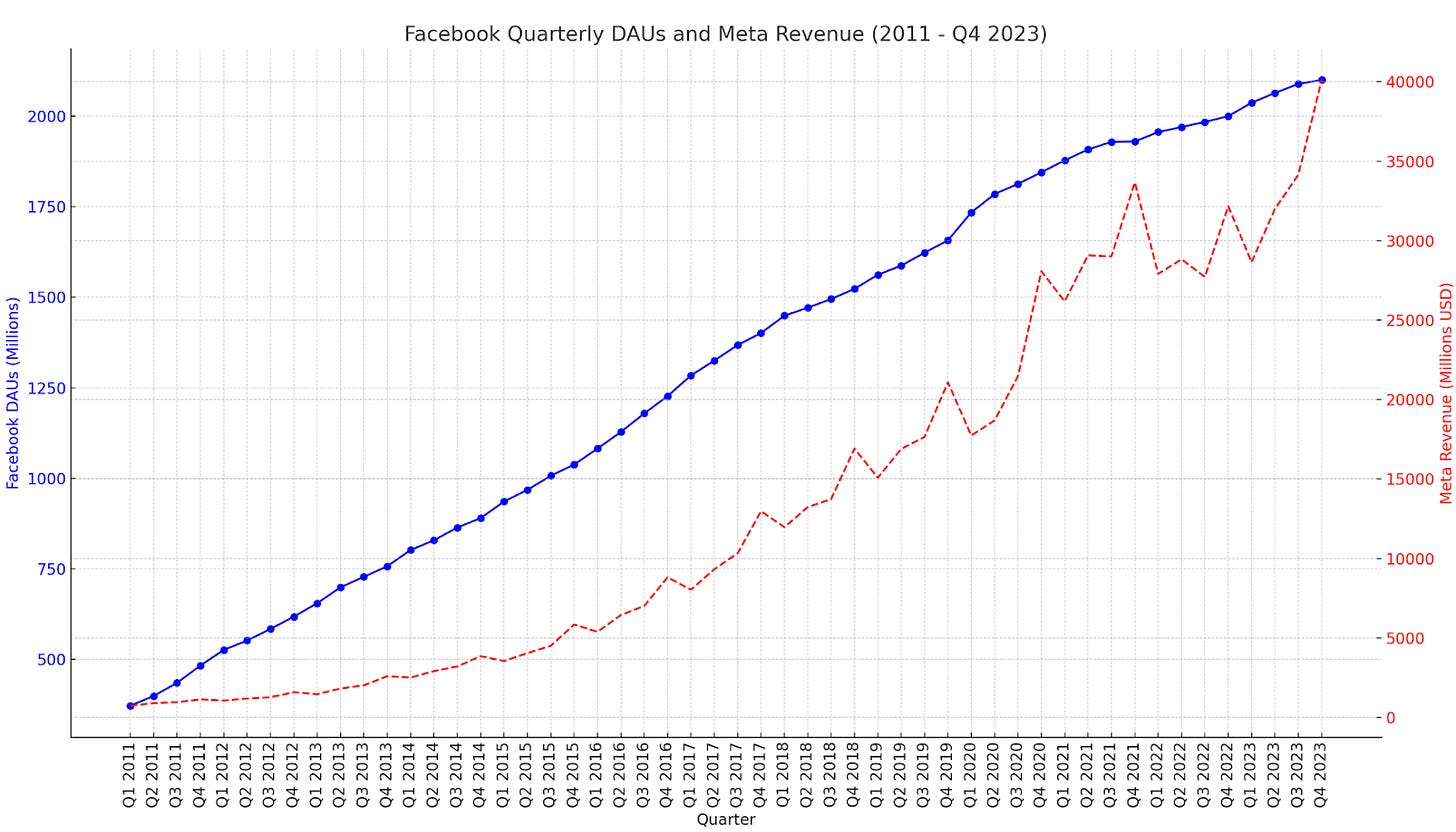The Siren Song of Advertising
How will ads affect AI business models?
F Scott Fitzgerald famously said, “The test of a first-rate intelligence is the ability to hold two opposing ideas in mind at the same time and still retain the ability to function.”
While I make no personal claims of first-rate intelligence, I’ve observed two opposing ideas from two people who undoubtedly do have first-rate intelligence:
“Show me the incentive and I will show you the outcome." - Charlie Munger
“I’m not saying OpenAI would never consider ads, but I don’t like them in general, and I think that ads-plus-AI is sort of uniquely unsettling to me.” - Sam Altman
In The Future of Foundation Model Business Models, I made the case for how foundation model companies would pursue profitability.
At the time, I laid out the case for vertical integration, profiting from applications, and using models as a differentiator. However, that argument was incomplete.
It focused on the 4% of paying ChatGPT customers, and not the 96% of free users. Advertising could be the answer to monetizing those users, which I’ve started to lay out in my previous two articles:
This article will be a bookend on that series, covering:
The Incentives of Advertising
The Challenges with Advertising
The Timing of AI Advertising
How will ads be implemented?
The impacts of AI & Advertising
Let’s get to it.
Disclaimer: ‘The Siren Song’ refers to the allure of advertising, but not necessarily the detrimental nature of the Sirens in classical Greek Mythology. Analogies can’t be perfect!
1. The Incentives of Advertising
In consumer technology, no business model better incentivizes all parties involved than advertising.
As we saw with the development of digital advertising, advertisers paid to use the platform because that’s where attention flowed, giving them a chance to influence consumers. Secondly, advertisers pay so much for advertisements because the user data and algorithms to target those users allows them to pay for improved odds of purchasing.
Over the last three years, we’ve seen attention flow to LLMs. With the development of memory, LLMs are getting to know their users. Secondly, and more importantly, we’re seeing the glimmer of a world where those LLMs take actions on your behalf. In that world, consumers no longer search for what toothbrush to buy; they ask their assistant to buy it for them.
How much would advertisers pay for hyper-targeted attention AND vastly improved odds of purchasing?
Put eloquently, a lot.
If ChatGPT were indeed able to aggregate purchasing into its app, that “Everything Engine” would create, in the words of Ben Thompson, “the most compelling ad opportunity since web search results pages.”
The Dual-Benefit of Advertising
The challenge with advertising has always been the perception that “the user is the product.” The challenge has never been how profitable the model is. Advertising helps monetize products in two ways:
It helps monetize the 96% of free users today (and in turn, helps build a sustainable business model that keeps those services free; i.e., advertising isn’t all bad).
It encourages free users who don’t like ads to upgrade to the paid version.
For OpenAI, the targeting of those free users is coming:
2. The Resistance to Advertising
Despite all of those incentives, there’s a remarkable consistency of companies resisting and then pursuing ads:
Google: "We expect that advertising-funded search engines will be inherently biased towards the advertisers and away from the needs of the consumers." - Page & Brin, The Anatomy of a Large-Scale Hypertextual Web Search Engine (1998)
Amazon: “Advertising is the price you pay for having an unremarkable product or service.” - Jeff Bezos
Perplexity: “Perplexity was founded on the belief that searching for information should be a straightforward, efficient experience, free from the influence of advertising-driven models.”
Netflix: “We want to be the safe respite where you can explore, you can get stimulated, have fun and enjoy - and have none of the controversy around exploiting users with advertising.” - Reed Hastings
Meta: I couldn’t find a direct quote, but I can quote The Acquired Podcast here: “The other thing that’s happening here is Mark still thought ads were gross at this point in history.”
This isn’t to disparage these companies at all, it’s to highlight the strength of the advertising business model!
Which leads us a few questions:
Why is the distaste for ads so consistent?
When do companies eventually make the shift to ads?
How can you introduce ads in a way that’s not detrimental to the user experience?
To keep the first answer short, the ethics of advertising have always been debated. Nobody likes the idea of “being the product.” Additionally, since LLMs give direct answers and not a suite of answers, influenced answers are particularly concerning. Finally, people are rightfully nervous about AI and its societal impacts. The idea of it being funded by advertising makes it even more concerning.
Because of this, figuring out the right way and time to introduce ads is especially important.
3. The Timing of AI Advertising
Different companies in the ecosystem have different incentives on how immediately they need to figure out advertising.
Google, for example, will be the first company to see lost revenue from traditional Search (given its market dominance). So they’re heavily incentivized to figure out the advertising model.
Perplexity, as well, is incentivized to figure out advertising, given their direct competition with Google. In their own words, “To fully deliver on our mission to spark the world’s curiosity, we need to invest in building not just a beloved product, but a robust and self-sustaining business.”
However, a company like OpenAI is less incentivized to pursue advertising in the short-term for two reasons:
1. Monetization follows attention, so the timing of monetization matters less.
For aggregators, the asset is the network of users. The monetization is a second-order effect. For example, take a look at Facebook’s Daily Active Users (DAUs) vs revenue over time:
Facebook DAUs over time have compounded at approximately 12% since IPO, while it’s revenue has compounded at 35% since IPO. The Instagram acquisition does change those numbers, but the point stands: focus on the user base, monetize later.
2. There’s no immediate need for profitability (i.e. they have plenty of funding.)
The parallels between search and LLMs are incredible, take a look at this article on Google’s early years:
For the first four years of Google’s life, they resisted advertising, despite the urging of the two venture capitalists, John Doerr and Michael Moritz, who had invested in Google and were upset that it was bleeding money. Brin and Page insisted that traditional banner ads would offend their users. They believed that if they built search traffic they would eventually engineer a way to make money; in the meantime, they hoped to improve people’s lives through information.
Eventually, Google pursued advertising because of pressure to find a sustainable business model. Investors like Mike Moritz started to get “antsy”, saying: “We really couldn’t figure out the business model…there was a period where things were looking pretty bleak.”
The pressure for a sustainable business model has historically been the impetus to pursue ads. Given the parallels between search and LLMs, I think ads will come, but they’ll come slowly.
4. How could ads be implemented?
From my observations, the incentives of advertising are too powerful to ignore. However, companies like OpenAI have the opportunity to be some of the largest companies in the world twenty and thirty years from now. So their brand is too important to damage with the idea of selling user data for personalized ads.
So, the question for these AI companies is how can you profit from aggregation without damaging the user experience?
Be hyperselective with the ads you show
Be hypersensitive about user data, don’t personalize ads at first.
Influence responses as little as possible
This lowers the maximum monetization potential of ads, and that’s okay. It’s much more important to do it ethically and correctly, than in a profit-maximizing way. Monetization follows aggregation.
Today, the initial attempts around ads are basic banner ads, suggested questions, and Pay-Per-Click Ads. Take Microsoft Copilot or Perplexity for example:
However, people come to LLMs for unbiased information. Because of this, it’s unlikely the AI providers provide personalized responses influenced by ads.
Why the affiliate strategy makes so much sense
With rumors of a Shopify and OpenAI partnership, an alternative path for AI providers is to surface personalized recommendations for e-commerce, centralize purchasing, and take a commission on any purchases through their platform.
Sam Altman hinted at this in his Stratechery Interview:
“The kind of thing I’d be much more excited to try than traditional ads is…e-commerce, for example, and is there a way that we could come up with some sort of new model…if you buy something through Deep Research that you found, we’re going to charge like a 2% affiliate fee or something.”
LLMs can combine the information search of Google, the personalized user data of social media, and (in the future) the proximity of purchase of Amazon.
E-commerce via LLMs saves users time, increases platform stickiness, and increases revenue for the merchant. It also allows platforms to very clearly demarcate ads vs non-ads; information is not influenced, but recommended actions are.
More interestingly, it gets users used to the action of buying through ChatGPT, which lays the path towards the absolute best case for ChatGPT.
For this to be really successful, ChatGPT would need to become more than an LLM. It’d look a lot more like super apps in other parts of the world. It could become the default go-to for shopping, search, and (maybe even) social media.
[To be clear, affiliate fees are not directly advertising; however, they are a means of monetizing free users with a clear path towards advertising.]
5. Who Does This Impact?
We’ve only seen a glimmer of the potential of new AI companies; in the early days of industries, it’s easier to see the losers than the winners.
As WB said,
“I’ve always said the easier thing to do is figure out who loses. And what you really should have done in 1905 or so, when you saw what was going to happen with the auto is you should have gone short horses. There were 20 million horses in 1900 and there’s about 4 million horses now. So it’s easy to figure out the losers, you know the loser is the horse.”
Traditional, ad-saturated ten-blue-links search will decline as users switch to LLMs. As we’ve seen with the last waves of digital advertising, monetization lags adoption. So while it will happen slowly, as search moves towards LLMs, eventually advertising dollars will try to move as well.
If this thesis turns out to be true, it provides not only a clear path for AI companies to generate sustainable business models, but it hints at the best-case scenario for today’s AI companies becoming the super apps of tomorrow.
Finally, it opens up a host of questions about the potential for new companies to be built around this ecosystem. I have to imagine those answers are stored in the minds of many first-rate intelligence people reading this, so feel free to reach out if you have thoughts.
As always, thanks for reading!
Disclaimer: The information contained in this article is not investment advice and should not be used as such. Investors should do their own due diligence before investing in any securities discussed in this article. While I strive for accuracy, I can’t guarantee the accuracy or reliability of this information. This article is based on my opinions and should be considered as such, not a point of fact. Views expressed in posts and other content linked on this website or posted to social media and other platforms are my own and are not the views of Felicis Ventures Management Company, LLC.






The affiliate revenue stream...very interesting. And makes lots of sense.